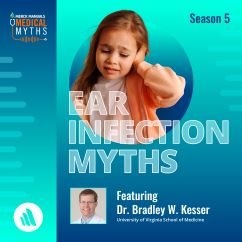Dermatitis of the ear canal is itching, scaling, flaking, and swelling of the skin of the ear canal and skin at the entrance of the ear canal.
There are 2 types of dermatitis of the ear canal:
Contact dermatitis
Eczema (aural eczematoid dermatitis)
Causes of Dermatitis of the Ear Canal
Contact dermatitis of the ear canal is an allergic reaction to triggers such as nickel-containing earrings and numerous beauty products (for example, hairsprays, lotions, and hair dye). Putting some substances in the ear (such as water or cotton swabs) can worsen the condition.
Aural eczematoid dermatitis of the ear canal can occur spontaneously in some people who have certain kinds of dermatitis-like conditions such as seborrheic dermatitis and psoriasis.
The skin irritation and cracking caused by dermatitis may enable bacterial or fungal ear canal infections (acute external otitis) to develop.
Symptoms of Dermatitis of the Ear Canal
Both types of dermatitis cause itching, redness, a clear discharge or moisture, and peeling, darkening, and painful cracking of the skin. In contrast, the first symptom of a bacterial infection is typically severe ear pain. Fungal ear canal infection causes more intense itching than pain.
Diagnosis of Dermatitis of the Ear Canal
A doctor's examination
Doctors can usually diagnose dermatitis of the ear canal based on symptoms and results of the physical examination.
Treatment of Dermatitis of the Ear Canal
Topical (and for severe cases, oral) corticosteroids
For contact dermatitis, elimination of allergic triggers
For aural eczematoid dermatitis, aluminum acetate solutionFor aural eczematoid dermatitis, aluminum acetate solution
To treat contact dermatitis, people should eliminate allergic triggers, especially earrings containing nickel, hairsprays, and possibly even hearing aid molds. Trial and error may be needed to identify the allergic trigger. Doctors give people a cream containing a corticosteroid such as hydrocortisone or betamethasone to decrease swelling and itching. For more severely inflamed ears, corticosteroids taken by mouth (such as prednisone) may be prescribed.people should eliminate allergic triggers, especially earrings containing nickel, hairsprays, and possibly even hearing aid molds. Trial and error may be needed to identify the allergic trigger. Doctors give people a cream containing a corticosteroid such as hydrocortisone or betamethasone to decrease swelling and itching. For more severely inflamed ears, corticosteroids taken by mouth (such as prednisone) may be prescribed.
To treat aural eczematoid dermatitis, doctors give people drops of a diluted aluminum acetate solution (Burow solution) to put in the ear as often as is required for comfort. Itching and swelling can be reduced with a cream containing a corticosteroid (such as betamethasone). Again, avoidance of all irritants to the ear canal, such as cotton swabs and water, is an important part of the treatment of this condition.doctors give people drops of a diluted aluminum acetate solution (Burow solution) to put in the ear as often as is required for comfort. Itching and swelling can be reduced with a cream containing a corticosteroid (such as betamethasone). Again, avoidance of all irritants to the ear canal, such as cotton swabs and water, is an important part of the treatment of this condition.
People with either type of dermatitis should avoid putting cotton swabs, water, and other possibly irritating substances in the ear.

